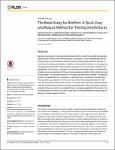The Bead Assay for Biofilms: A Quick, Easy and Robust Method for Testing Disinfectants
Konrat, Katharina
Schwebke, Ingeborg
Laue, Michael
Dittmann, Christin
Levin, Katja
Andrich, Ricarda
Arvand, Mardjan
Schaudinn, Christoph
Bacteria live primarily in microbial communities (biofilms), where they exhibit considerably higher biocide tolerance than their planktonic counterparts. Current standardized efficacy testing protocols of disinfectants, however, employ predominantly planktonic bacteria. In order to test the efficacy of biocides on biofilms in a standardized manner, a new assay was developed and optimized for easy-handling, quickness, low running costs, and above all—repeatability. In this assay, 5 mm glass- or polytetrafluoroethylene beads in 24 well microtiter plates served as substrate for Pseudomonas aeruginosa biofilms. After optimizing result-relevant steps, the actual performance of the assay was explored by treating P. aeruginosa biofilms with glutaraldehyde, isopropanol, or peracetic acid in predefined concentrations. The aspired 5 log10 reduction in CFU counts was achieved by glutaraldehyde at 5% (30 min), and by peracetic acid at 0.3% (10 min). In contrast, 80% isopropanol (30 min) failed to meet the reduction goal. However, the main accomplishment of this study was to unveil the potential of the array itself; most noteworthy here, a reliable repeatability of the results. The new bead assay for biofilms is a robust, quick and cost-effective method for assessing the efficacy of biocides against biofilms.
No license information

